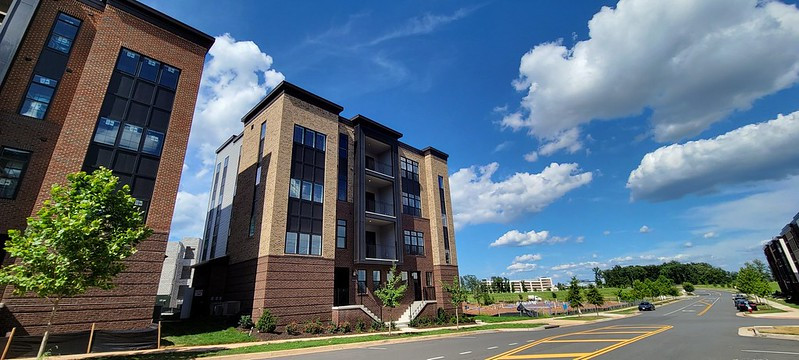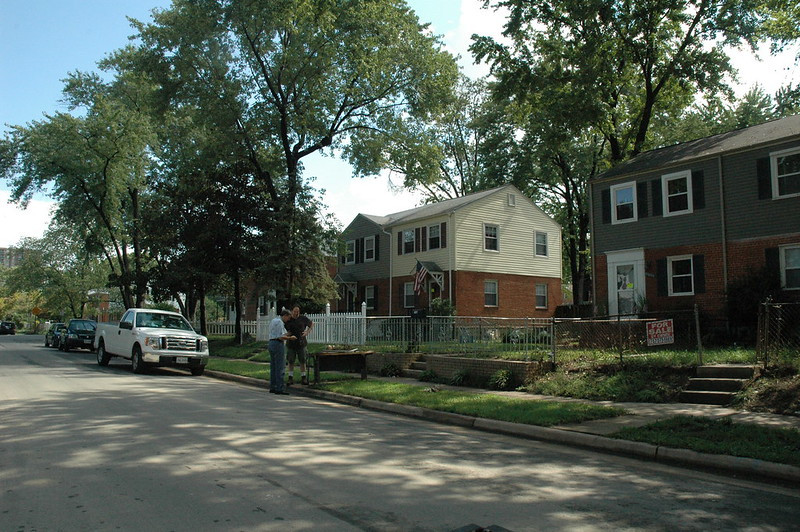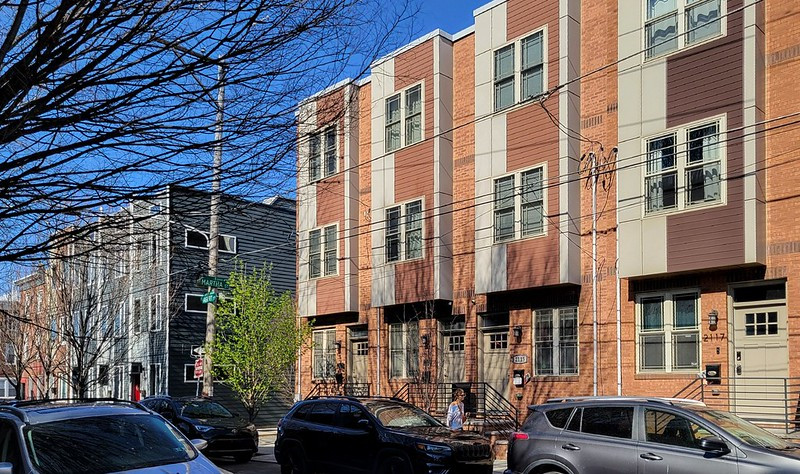How single-stair apartments can improve fire safety
_800_533_90.jpg)
The award-winning XS House in Philadelphia squeezes seven units into a single-stair IBC building, but only with very creative spatial arrangement and very narrow dimensions. Image by the author.
A hot new buzzword among pro-housing advocates is “single-stair point access blocks.” Activists and legislators in several cities and states are advancing legislation that would allow low-rise, small-footprint multifamily buildings to be built with just one staircase shared amongst the units, rather than the two currently required by nearly all building codes in North America. Seattle was the first city to make the change, and now similar policies are underway across the continent. In Virginia, a bill to re-examine fire codes, and specifically stair requirements, unanimously passed the General Assembly last month, and is now law.
Much has been written and said about the architectural superiority of single-stair multifamily buildings. As Stephen Smith writes, “the common hallway that must connect the two stairs in a modern American code-compliant building cuts the structure in two, cutting off the possibility of floor-through apartments found” elsewhere in the world or in historic American buildings.
Garden apartments, the greater Washington area’s primary contribution to 20th century American multifamily vernacular architecture, are often configured as low-rise single-stair point-access blocks. Advocates say that allowing new buildings to repeat those historic forms would ease housing construction, especially on small urban sites.
Some people’s initial fear is that requiring only one staircase would roll back safety regulations to cut costs. But in fact, single-stair reforms have the potential to get more people into safer buildings.
Safety advances should be evaluated together
“One of the most underappreciated success stories of the past 100 years” has been the miraculous decline in the fire death rate: by 90% over the past century and by 60% since just 1980. Some factors include less smoking and widespread smoke detectors.
Multifamily buildings are now particularly safe from fire deaths, largely due to building code requirements for sprinklers. The National Fire Protection Association notes that in 1980, house and multifamily fires had comparable chances of causing deaths; by 2022, the death rate for multifamily fires had fallen 17% while those for house fires had actually risen. Yet because sprinklers are usually only installed in new apartments, their adoption has been slow; only 7% of home fires happen in sprinklered residences. Increasing the number of sprinklered residences is key to further advancing fire safety.
Second staircases are a holdover from early fire codes, which focused on evacuating occupants; since then, material and building science advances have improved our ability to isolate and suppress fires, and firefighting equipment has improved. Because of those advances, the commercial code’s continued insistence on extra staircases amounts to a “belt and suspenders” approach to fire safety. Just as suspenders were replaced by belts in the early 20th century, perhaps it’s time for fire codes to evolve beyond the second stair.
The single-stair bill pending in Virginia directs safety officials to study how to allow single-stair multifamily buildings, and to recommend what complementary safety measures should be taken instead.
Three-story flats like these in Norfolk and Montreal provide the density for many of the continent’s most walkable neighborhoods. They were often built with one interior staircase – or, in Montreal, zero, since both staircases are external. Image by the author.
Point access blocks would be a safety upgrade for many homebuyers
Allowing single-stair buildings has the potential to get more people into safer buildings, by allowing better alternatives to less-safe townhouses and existing houses.
Today, the homebuilding industry offers middle-class buyers of new houses a few different formats for low-rise, attached housing in the few places where it’s allowed. Let’s compare several newly built, recently sold, family-sized houses in the transit-oriented Moorefield Station area of Loudoun County, south of the Ashburn Metro. This comparison shows how the intersection of prices, building codes, and fire safety results in tradeoffs for both homebuyers and policymakers.
New townhouses in Oklahoma City. Image by the author.
Townhouses up to three stories tall can be built under the “residential code” (formally the International Residential Code, or IRC), which offers only basic fire protections. Indeed, the fire death rate in residential code structures is now twice as high as for multifamily fires. In Virginia, as in most of America, residential code doesn’t require sprinklers; in DC and Maryland the residential codes do.
The vast majority of Americans live in residential code houses because they’re economical. A new three-story townhouse on Foundation Drive recently sold for $256 per square foot. That’s quite economical compared to the regional median house listing price of $318 per square foot.
New stacked townhouses in Tysons. Image by the author.
“Two-over-twos,” or stacked townhouses, are a popular new-house type in DC’s suburbs: as Dan Reed explains, they’re “basically a rowhouse divided into two two-story units, one over the other.” These four-story buildings are tall enough for the stricter “commercial” building code (formally the International Building Code, or IBC). Commercial code requires an array of fire protections, including sprinklers throughout, plus walls, doors, and stairs rated to withstand fire and smoke. Stacked townhouses can provide upper floors one staircase, because every unit touches the ground.
More-complex construction raises costs; the stacked townhouse units on Midmoore Drive have recently sold for an average price of $320 per square foot – just above the regional median price, and more than a townhouse. Yet because stacked townhouse units are smaller than townhomes, they sell at a lower total price; the only newly built, family-sized homes available near Metro in Northern Virginia under the $725,000 price limit for state-assisted first time homebuyer loans are all stacked townhouses.
New flats in Ashburn. Image by the author.
At the upper end of the price per square foot scale are flats. Moorefield Station is one of the few places in America where I’ve seen new three-flat condos for sale in recent years. These four-story buildings have garages on the ground floor, an elevator, and three spacious, ranch-house style flats on the three floors above. Not having stairs within the unit is important for many households, particularly seniors and many people with disabilities.
Unlike the historic flats in many cities, today three-flats are subject to not only the commercial code and its sprinkler requirement, but also must have two staircases because multiple units share the stairs. Those stairs must be protected from fire with masonry walls and fire doors. Flats also appreciably more expensive: a flat on Springside Terrace sold for $385 per square foot.
Older two-unit townhouses in Fairfax County. Photo by Fairfax County Government. 
Of course, middle-class homebuyers always have an even cheaper option: moving into older existing housing. About 80% of American houses were built before 2000, and the median American house was built in 1979.
Current fire codes are never applied to existing houses until they’re substantially remodeled or expanded, and as a result older houses have countless fire safety disadvantages, including inadequate electric wiring, leaky gas pipes, exposed structural beams, and non-fire-retardant materials.
Stricter building codes have opportunity costs
Raising standards for new construction raises the cost of newly constructed buildings. That means newer buildings get built at higher price points, which reduces the demand for new construction. That also means that fewer people benefit from the higher standards applied to new buildings, and more people have to make do with flawed existing buildings.
Applying a strict two-stair requirement for three-flat buildings means that it’s always more cost effective for a homebuyer to choose a new townhouse over a new flat: in Moorefield Station, the better fire protected, more convenient flat costs 50% more per foot than a comparable townhouse. The two-stair requirement also means that it’s more cost effective for a developer to build three townhouses on a site, rather than three flats.
Buildings in Philadelphia. Building code differences mean it’s almost always more economical to build even three or four unit buildings as townhouses than as flats. Image by the author.
Note that four-floor multifamily buildings can already have a single stair — in a two-over-two. Furthermore, those units can be built at typical prices for our region’s housing market. Dividing that into three units, though, currently kicks in a costly requirement for a second stair.
Allowing smaller single-stair flats to be built would open up many new housing choices for many Americans who want newer, safer, lower-maintenance, denser housing — but don’t want townhouses. Those include many seniors, whose numbers are growing by 1.5 million a year. A lack of acceptable new houses to downsize into in their communities of choice is among the factors leading many seniors to instead age in place (in homes that may not suit their evolving needs), a key cause of record-low housing inventory.
Denser housing and denser neighborhoods are safer
Single-stair buildings are uniquely suited to densifying thousands of small infill sites that exist within dense, walkable neighborhoods. Requiring two standard-sized staircases (plus a hallway connecting them) inside every residential building, whether it has two or 52 units per floor, creates a strong incentive to go big with building sizes.
Legalizing single-stair buildings will allow more people to live in dense urban places, which themselves have substantial life safety benefits:
- More urban places have lower fire death rates, perhaps due in part to faster fire response times, with the most urban states seeing per-capita fire death rates half that of less-urbanized states.
- More urban places have lower overall injury-related death, particularly since the risk of car crash death is half as high in urban areas as rural areas. Car crashes kill nearly 100 times as many Americans as multifamily fires, so lowering the car crash death rate only slightly has the potential to save many lives.
- More urban places discourage driving and instead encourage walking, which Hippocrates called “man’s best medicine.” Adding just 10 minutes of walking to the average American’s day would prevent 110,000 deaths a year, over 200 times the number of annual deaths from multifamily fires.
Multifamily buildings with sprinklers are America’s safest homes in case of fire. The safe choice is to add more of them, in neighborhoods that are safer from harm, and at price points that more Americans can afford.
